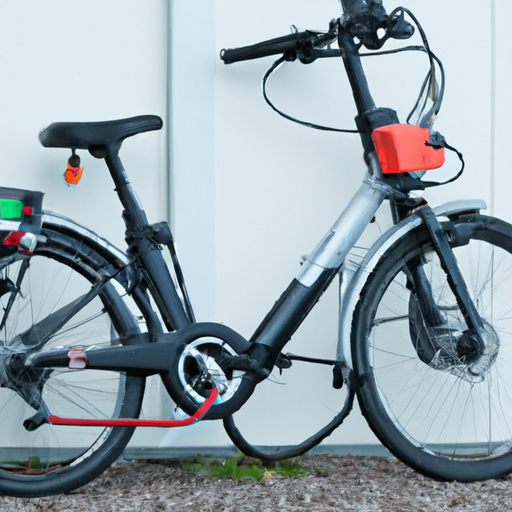Curious about electric bikes and want to know more? Look no further! In this article, we will provide you with all the essential information you need to understand what an electric bike is. Whether you’re a beginner trying to navigate the world of e-biking or simply curious about this new form of transportation, we’ve got you covered. From the basics of electric bike riding to tips for a smooth transition into becoming a confident e-biker, we aim to equip you with the foundational knowledge you need. So, let’s get started and explore the exciting world of electric bikes!

What is an electric bike?
An electric bike, also known as an e-bike, is a bicycle that is powered by an electric motor along with human pedaling. It is designed to provide an assisted ride, allowing riders to travel faster and farther with less effort. With an electric bike, you can enjoy all the benefits of cycling while harnessing the power of electricity to make your journey easier and more enjoyable.
Overview of Electric Bikes
Definition of an Electric Bike
An electric bike is a bicycle that is equipped with an electric motor, usually located in the rear hub or on the crankshaft, which provides a boost to the rider’s pedaling power. The level of assistance can be adjusted, allowing riders to choose how much help they receive from the motor. The electric motor is powered by a rechargeable battery, typically located on or near the bike’s frame.
How Electric Bikes Work
Electric bikes work by combining the power of human pedaling with the assistance of an electric motor. When the rider pedals the bike, a sensor detects their pedaling motion and sends a signal to the motor to provide assistance. The motor then provides additional power to the bike’s drivetrain, helping the rider to accelerate and maintain speed with less effort. The level of assistance can be adjusted using a throttle or pedal assist system.
Benefits of Electric Bikes
There are numerous benefits to riding an electric bike. Firstly, electric bikes make commuting and traveling longer distances much easier and more efficient. The added assistance from the electric motor allows riders to cover greater distances without becoming fatigued. Electric bikes are also a great option for individuals with physical limitations or health conditions that may prevent them from riding a traditional bike.
Another benefit of electric bikes is their environmental friendliness. By using an electric motor instead of relying solely on fossil fuels, electric bikes have a significantly smaller carbon footprint compared to motorcycles or cars. They also offer a more sustainable mode of transportation, reducing traffic congestion and the need for parking spaces.
Finally, electric bikes are a fun and enjoyable way to explore the outdoors and stay active. They provide the perfect balance between exercise and convenience, allowing riders to enjoy the experience of cycling while also getting a boost of power when needed.
Different Types of Electric Bikes
There are several different types of electric bikes available, each designed to cater to specific riding preferences and terrains. Some common types include:
-
Commuter Electric Bikes: These bikes are designed for urban commuting and are equipped with features such as fenders, lights, and racks for carrying cargo.
-
Mountain Electric Bikes: These bikes are built for off-road adventures and feature rugged frames, wide tires, and suspension systems to handle rough terrains.
-
Folding Electric Bikes: These bikes are compact and easily foldable, making them ideal for commuters or those with limited storage space.
-
Fat-Tire Electric Bikes: These bikes are equipped with extra-wide tires, offering increased stability and traction on varied terrains, such as snow or sand.
-
Cargo Electric Bikes: These bikes are designed for carrying heavy loads, with sturdy frames and extended rear racks for transporting groceries or other items.
Components of an Electric Bike
Electric Motor
The electric motor is the heart of an electric bike, providing the power to propel the bike forward. The motor can be located in various positions, such as the rear hub, front hub, or the crankshaft. It is typically powered by a rechargeable battery and can have different power outputs, ranging from 250 watts to 750 watts or more.
Battery
The battery is what powers the electric motor and is usually located on or near the bike’s frame. It is typically a lithium-ion battery, which offers a good balance of power and weight. The capacity of the battery, measured in watt-hours (Wh), determines the range and power assistance of the electric bike. Higher-capacity batteries can provide longer rides before requiring a recharge.
Throttle or Pedal Assist System
Electric bikes can have either a throttle or a pedal assist system (PAS) to control the level of assistance provided by the motor. A throttle is a hand-controlled lever that allows riders to activate the motor without pedaling. On the other hand, a pedal assist system uses sensors to detect the rider’s pedaling motion and provides assistance accordingly. PAS systems usually have multiple levels of assistance, allowing riders to choose the desired amount of help.
Display and Control Unit
The display and control unit on an electric bike provide riders with information about their speed, distance traveled, battery level, and other important data. It also allows riders to adjust the level of assistance and monitor various settings of the electric bike. The display is typically located on the handlebars for easy access and visibility while riding.
Brakes
Electric bikes are equipped with brakes to ensure safe and controlled stopping. There are two main types of brakes commonly found on electric bikes: mechanical brakes and hydraulic brakes. Mechanical brakes use cables to activate the brake pads, while hydraulic brakes use fluid to transmit force to the brake pads. Both types of brakes can provide reliable stopping power, but hydraulic brakes generally offer better modulation and performance.
Gears
Gears on an electric bike allow riders to change the resistance and optimize their pedaling effort. Electric bikes can have either a traditional derailleur gear system or an internally geared hub. Derailleur systems are lighter and offer a wide range of gear options, while internally geared hubs are more durable and require less maintenance. The number of gears can vary depending on the bike’s intended use and terrain.
Frame and Suspension
The frame of an electric bike plays a crucial role in providing stability and support. Electric bike frames are typically made from materials such as aluminum, steel, or carbon fiber. The frame’s design can vary depending on the type of bike, with mountain bikes featuring suspension systems to absorb shocks and improve ride comfort on rough terrains.
Wheels and Tires
The wheels and tires of an electric bike are important for achieving a smooth and comfortable ride. Electric bikes usually have larger and sturdier wheels compared to regular bikes, offering better stability and traction. Tires can vary in width and tread pattern, depending on the bike’s intended use. For example, wide and knobby tires are suitable for off-road adventures, while narrow and smooth tires are more ideal for road biking.
Electric Bike vs. Regular Bike
Speed and Range
One of the main advantages of an electric bike over a regular bike is the increased speed and range. The electric motor provides a boost of power, allowing riders to reach higher speeds with less effort. Electric bikes typically have a top speed of 20 to 28 mph, depending on the model and local regulations. In terms of range, electric bikes can travel anywhere from 20 to 100 miles on a single charge, depending on factors such as battery capacity, terrain, and rider input.
Ease of Use
Electric bikes are generally easier to ride compared to regular bikes, especially for individuals who may have physical limitations or lack confidence in their cycling abilities. The electric motor provides assistance, making it easier to climb hills or ride against strong headwinds. Electric bikes also offer the option of using a throttle, allowing riders to activate the motor without pedaling.
Cost
Electric bikes are generally more expensive than regular bikes due to the added components, such as the motor and battery. However, the cost of electric bikes has become more affordable in recent years, with a wide range of models available at different price points. It is important to consider the long-term cost savings of using an electric bike, such as reduced fuel and maintenance expenses.
Environmental Impact
Electric bikes are considered a more environmentally-friendly mode of transportation compared to regular bikes. While both types of bikes have minimal carbon emissions, electric bikes rely on electricity as a power source, which can be produced from renewable energy sources. By choosing an electric bike over a car or motorcycle, riders can significantly reduce their carbon footprint and contribute to a cleaner environment.

Choosing an Electric Bike
Consider Your Riding Needs
When choosing an electric bike, it is important to consider your riding needs and preferences. Think about the types of terrain you will be riding on, the distance you plan to travel, and whether you will be using the bike for commuting or recreational purposes. Understanding your specific riding needs will help you choose the right type and features of an electric bike.
Power and Performance
The power and performance of an electric bike are determined by factors such as the wattage of the motor, the battery capacity, and the torque output. Higher wattage motors and larger capacity batteries generally provide more power and assistance. Consider how much power you need based on the terrain and your desired level of assistance.
Battery Capacity
Battery capacity is an important factor to consider when choosing an electric bike. A higher capacity battery will provide a longer range, allowing you to cover more distance on a single charge. Consider your daily riding needs and choose a battery capacity that will comfortably meet your requirements.
Range and Charging
The range of an electric bike refers to the distance it can travel on a single charge. Factors such as rider weight, terrain, and assistance level can affect the range. Consider how far you need to travel on a regular basis and choose an electric bike with a range that comfortably meets your needs. Additionally, consider the charging time of the battery. Some batteries can be fully charged in a few hours, while others may take longer.
Comfort and Ergonomics
Comfort is essential when choosing an electric bike, as it can greatly influence your overall riding experience. Consider the bike’s geometry, saddle, handlebars, and suspension systems, if applicable. Ensure that the bike’s ergonomics are well-suited to your body type and riding style.
Durability and Maintenance
Choose an electric bike that is built to last and requires minimal maintenance. Look for bikes with high-quality components and materials that can withstand regular use. Consider the brand’s reputation for reliability and customer support when making your decision.
Budget
Lastly, consider your budget when choosing an electric bike. Electric bikes can vary greatly in price, depending on factors such as brand, features, and build quality. Set a budget range that you are comfortable with and explore options within that range. Remember to consider the long-term cost savings of using an electric bike compared to other modes of transportation.
Safety and Legal Considerations
Safety Equipment
When riding an electric bike, it is important to prioritize safety and wear the necessary protective equipment. Always wear a properly fitted helmet to protect your head in case of an accident. Additionally, consider wearing reflective clothing or using lights to improve your visibility, especially when riding at night or in low-light conditions.
Traffic Laws and Regulations
Before riding an electric bike, familiarize yourself with the local traffic laws and regulations that apply to electric bikes. Laws can vary from one jurisdiction to another, so it is essential to understand the rules regarding speed limits, bike lanes, and licensing requirements. Adhere to these laws and be aware of your rights and responsibilities as an electric bike rider.
Pedestrian and Cyclist Etiquette
Respect pedestrians and other cyclists when riding an electric bike. Follow proper etiquette, such as signaling your turns, yielding to pedestrians at crosswalks, and sharing multi-use paths. Maintain a safe speed and always be mindful of your surroundings to avoid accidents and conflicts with others.
Insurance and Licensing
In some jurisdictions, electric bike riders may be required to have insurance and obtain a license or registration for their electric bike. Check the local regulations to determine if these requirements apply to you. Even if not legally required, it may be wise to have insurance coverage to protect yourself and your electric bike in case of theft or accidents.

Tips for Riding an Electric Bike
Practice in a Safe Area
If you are new to riding an electric bike, it is advisable to practice in a safe and open area before venturing onto busy roads or challenging terrain. Familiarize yourself with the bike’s handling and responsiveness, practice starting and stopping, and get comfortable with the different levels of assistance.
Get Familiar with Bike Features
Take the time to understand the features and controls of your electric bike. Read the user manual and learn how to adjust the assistance level, read the display, and operate any additional features such as lights or a horn. Getting familiar with these features will make your rides safer and more enjoyable.
Start Slow and Gradually Increase
When riding an electric bike for the first time, start at a slow and comfortable pace. Gradually increase your speed and level of assistance as you become more confident and familiar with the bike’s handling. This will help you build your skills and maintain control over the bike.
Learn Proper Braking Techniques
Braking is an essential skill to master when riding an electric bike. Understand the braking system of your bike and practice proper braking techniques, such as evenly distributing the brake force between the front and rear brakes. This will ensure efficient and safe braking, especially in emergency situations.
Pay Attention to Traffic
Always be aware of your surroundings and pay attention to traffic when riding an electric bike. Use your mirrors, if equipped, to monitor vehicles approaching from behind, and make sure to signal your intentions when turning or changing lanes. Stay vigilant and anticipate the actions of other road users to prevent accidents.
Maintain a Comfortable Riding Posture
Proper riding posture is essential for comfort and control when riding an electric bike. Keep your back straight, your shoulders relaxed, and your arms slightly bent. Distribute your weight evenly between the saddle and handlebars, and adjust the saddle height to ensure a comfortable and efficient pedaling motion.
Be Mindful of Battery Levels
To avoid being stranded with a depleted battery, it is important to be mindful of the battery levels on your electric bike. Keep an eye on the battery indicator or display and plan your rides accordingly. Avoid draining the battery completely and aim to recharge it before it reaches critically low levels.
Keep an Eye on Weather Conditions
Weather conditions can greatly impact your riding experience and safety. Keep an eye on the weather forecast before heading out on your electric bike and dress appropriately for the conditions. Be cautious when riding in wet or slippery conditions, as braking and handling may be affected.
Take Regular Maintenance Checks
Regular maintenance checks are important to ensure the safe and efficient operation of your electric bike. Inspect the bike for any signs of damage or wear, check the tire pressure, and ensure that all components are properly tightened. Regularly clean and lubricate the chain, and have the bike serviced by a professional when necessary.
Join a Community or Group
Joining a community or group of electric bike enthusiasts can be a great way to gain valuable knowledge and learn from experienced riders. Look for local biking clubs or online forums where you can connect with like-minded individuals, share tips and advice, and participate in group rides. This can enhance your overall riding experience and help you make new friends.
Maintenance and Care
Battery Maintenance
Proper battery maintenance is essential for the longevity and performance of your electric bike. Follow the manufacturer’s instructions for charging and storage, and avoid exposing the battery to extreme temperatures. Regularly check the battery’s connections and clean them if necessary. If the battery shows signs of deterioration, such as reduced range or capacity, consider having it inspected or replaced.
Cleaning and Lubrication
Regular cleaning and lubrication of your electric bike’s components will help maintain their performance and prolong their lifespan. Use a mild detergent and water to clean the frame, wheels, and other parts. Wipe down the chain and gears, and apply lubricant to ensure smooth and efficient operation. Avoid using high-pressure water or solvents that may damage the bike’s components.
Tire Maintenance
Proper tire maintenance is important for a safe and comfortable ride. Regularly check the tire pressure and inflate them to the manufacturer’s recommended levels. Inspect the tires for any signs of wear, such as cracks or bulges, and replace them if necessary. Additionally, check the tread for any embedded debris, such as glass or nails, and remove them to prevent punctures.
Regular Check-ups and Tune-ups
Just like any other vehicle, electric bikes require regular check-ups and tune-ups to ensure their safety and performance. Consider scheduling regular maintenance appointments with a professional bike shop to inspect and service your bike. They can check and adjust the brakes, gears, and other components, as well as perform any necessary repairs or replacements.
Storage and Winterization
Proper storage and winterization are important if you plan to leave your electric bike unused for an extended period or during the winter months. Clean the bike thoroughly and ensure it is dry before storing it in a cool and dry place. If possible, remove the battery and store it separately in a cool and dry location. Consider covering the bike to protect it from dust, moisture, and other environmental factors.

Common Troubleshooting
Electric System Issues
If you encounter issues with the electric system of your bike, such as the motor not engaging or the assistance level not working properly, try the following troubleshooting steps:
- Check the battery level to ensure it is adequately charged.
- Ensure all connections are securely plugged in and there are no loose wires.
- Restart the bike’s system by turning it off and back on.
If the issue persists, consult the manufacturer’s manual or contact customer support for further assistance.
Brake Problems
If you experience issues with the brakes of your electric bike, such as squeaking or reduced stopping power, try the following troubleshooting steps:
- Check the brake pads for wear and replace them if necessary.
- Inspect the brake cables or hydraulic lines for any signs of damage or leakage.
- Adjust the brake calipers to ensure proper alignment and contact with the brake discs or rims.
If the issue persists, have the brakes inspected and serviced by a professional bike mechanic.
Tire Punctures
Punctures or flat tires can be a common occurrence when riding any type of bike. If you get a puncture on your electric bike, follow these steps to address the issue:
- Remove the wheel with the punctured tire from the bike.
- Locate the puncture by submerging the inflated tire in water or listening for escaping air.
- Patch the puncture using a tire patch kit or replace the tube if necessary.
- Reinstall the repaired or new tube and inflate the tire to the recommended pressure.
If you are unsure or uncomfortable performing a tire repair, take your bike to a professional bike shop.
Chain and Gear Maintenance
Proper chain and gear maintenance is essential for smooth shifting and optimal performance. If you encounter issues such as skipping gears or difficulty shifting, try the following troubleshooting steps:
- Clean the chain and gears to remove any dirt or debris.
- Inspect the chain for wear or stretching and replace it if necessary.
- Adjust the derailleurs or internally geared hub to ensure proper alignment and tension.
If the issue persists, consult a professional bike mechanic for further assistance.
Electronics and Display Malfunctions
If you experience malfunctions with the electronics or display unit of your electric bike, such as a blank screen or incorrect readings, try the following troubleshooting steps:
- Check the battery level and ensure it is adequately charged.
- Make sure all connections between the display and control unit are secure.
- Restart the bike’s system by turning it off and back on.
If the issue persists, consult the manufacturer’s manual or contact customer support for further assistance.
Conclusion
Electric bikes offer a convenient and sustainable mode of transportation, providing riders with the benefits of cycling while enhancing their experience with electric assistance. By understanding the components, choosing the right electric bike, and following safety guidelines and maintenance routines, you can maximize the enjoyment and longevity of your electric bike. Whether you’re commuting to work, exploring new trails, or simply enjoying the outdoors, an electric bike can revolutionize your riding experience. So hop on, embrace the power of electricity, and enjoy the ride!




